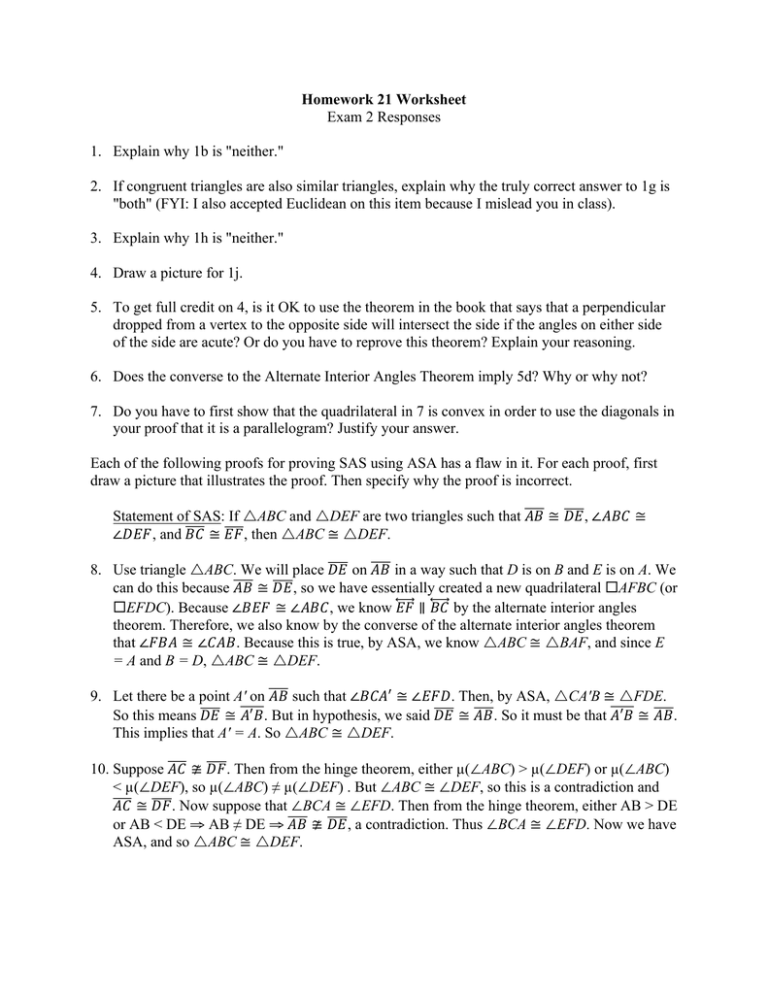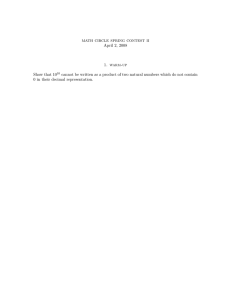Homework 21 Worksheet
advertisement

Homework 21 Worksheet Exam 2 Responses 1. Explain why 1b is "neither." 2. If congruent triangles are also similar triangles, explain why the truly correct answer to 1g is "both" (FYI: I also accepted Euclidean on this item because I mislead you in class). 3. Explain why 1h is "neither." 4. Draw a picture for 1j. 5. To get full credit on 4, is it OK to use the theorem in the book that says that a perpendicular dropped from a vertex to the opposite side will intersect the side if the angles on either side of the side are acute? Or do you have to reprove this theorem? Explain your reasoning. 6. Does the converse to the Alternate Interior Angles Theorem imply 5d? Why or why not? 7. Do you have to first show that the quadrilateral in 7 is convex in order to use the diagonals in your proof that it is a parallelogram? Justify your answer. Each of the following proofs for proving SAS using ASA has a flaw in it. For each proof, first draw a picture that illustrates the proof. Then specify why the proof is incorrect. Statement of SAS: If ABC and DEF are two triangles such that 𝐴𝐵 ≅ 𝐷𝐸, ∠𝐴𝐵𝐶 ≅ ∠𝐷𝐸𝐹, and 𝐵𝐶 ≅ 𝐸𝐹, then ABC ≅ DEF. 8. Use triangle ABC. We will place 𝐷𝐸 on 𝐴𝐵 in a way such that D is on B and E is on A. We can do this because 𝐴𝐵 ≅ 𝐷𝐸, so we have essentially created a new quadrilateral AFBC (or EFDC). Because ∠𝐵𝐸𝐹 ≅ ∠𝐴𝐵𝐶, we know 𝐸𝐹 ∥ 𝐵𝐶 by the alternate interior angles theorem. Therefore, we also know by the converse of the alternate interior angles theorem that ∠𝐹𝐵𝐴 ≅ ∠𝐶𝐴𝐵. Because this is true, by ASA, we know ABC ≅ BAF, and since E = A and B = D, ABC ≅ DEF. 9. Let there be a point A' on 𝐴𝐵 such that ∠𝐵𝐶𝐴′ ≅ ∠𝐸𝐹𝐷. Then, by ASA, CA'B ≅ FDE. So this means 𝐷𝐸 ≅ 𝐴′𝐵. But in hypothesis, we said 𝐷𝐸 ≅ 𝐴𝐵. So it must be that 𝐴′𝐵 ≅ 𝐴𝐵. This implies that A' = A. So ABC ≅ DEF. 10. Suppose 𝐴𝐶 ≇ 𝐷𝐹. Then from the hinge theorem, either µ(∠ABC) > µ(∠DEF) or µ(∠ABC) < µ(∠DEF), so µ(∠ABC) ≠ µ(∠DEF) . But ∠ABC ≅ ∠DEF, so this is a contradiction and 𝐴𝐶 ≅ 𝐷𝐹. Now suppose that ∠BCA ≅ ∠EFD. Then from the hinge theorem, either AB > DE or AB < DE ⇒ AB ≠ DE ⇒ 𝐴𝐵 ≇ 𝐷𝐸, a contradiction. Thus ∠BCA ≅ ∠EFD. Now we have ASA, and so ABC ≅ DEF.


